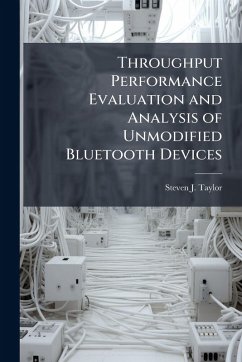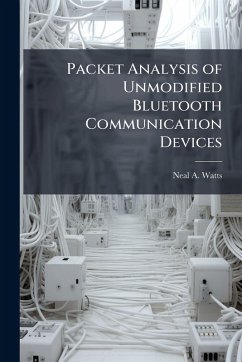
Performance Evaluation and Analysis of Effective Range and Data Throughput for Unmodified Bluetooth Communication Devices
Versandkostenfrei!
Versandfertig in über 4 Wochen
17,99 €
inkl. MwSt.

PAYBACK Punkte
9 °P sammeln!
The DoD and the Air Force continually seek to incorporate new technology in an effort to improve communication, work effectiveness, and efficiency. Office devices utilizing Bluetooth technology simplify device configuration and communication. They provide a means to communicate wirelessly over short distances thereby eliminating the need for different vendor specific cables and interfaces. One of the key concerns involved in incorporating new communication technology is security; the fundamental security concern of wireless communication is interception. Studies focusing on IEEE 802.11b have s...
The DoD and the Air Force continually seek to incorporate new technology in an effort to improve communication, work effectiveness, and efficiency. Office devices utilizing Bluetooth technology simplify device configuration and communication. They provide a means to communicate wirelessly over short distances thereby eliminating the need for different vendor specific cables and interfaces. One of the key concerns involved in incorporating new communication technology is security; the fundamental security concern of wireless communication is interception. Studies focusing on IEEE 802.11b have shown vulnerability zones around many DoD installations that reflect the ranges at which wireless communications using the 802.11b standard can be intercepted. This research identifies the vulnerability zones in which Bluetooth transmissions can potentially be intercepted. Specifically, the orientation of Bluetooth device antenna and the distance between devices are varied to determine ranges at which set levels of throughput can be achieved for a specific device configuration. Throughput ranges are then mapped to graphically reflect vulnerability zones. This research shows that the range at which Bluetooth communication can occur with unmodified devices is more than twice that of the minimum standard of 10 m outlined in the core specification without degradation of the best-case throughput level measured. It is expected that the throughput ranges could be greatly extended with some device modification. This research shows that the security risk associated with interception of Bluetooth communications is legitimate and warrants further study. This work has been selected by scholars as being culturally important, and is part of the knowledge base of civilization as we know it. This work was reproduced from the original artifact, and remains as true to the original work as possible. Therefore, you will see the original copyright references, library stamps (as most of these works have been housed in our most important libraries around the world), and other notations in the work. This work is in the public domain in the United States of America, and possibly other nations. Within the United States, you may freely copy and distribute this work, as no entity (individual or corporate) has a copyright on the body of the work. As a reproduction of a historical artifact, this work may contain missing or blurred pages, poor pictures, errant marks, etc. Scholars believe, and we concur, that this work is important enough to be preserved, reproduced, and made generally available to the public. We appreciate your support of the preservation process, and thank you for being an important part of keeping this knowledge alive and relevant.












